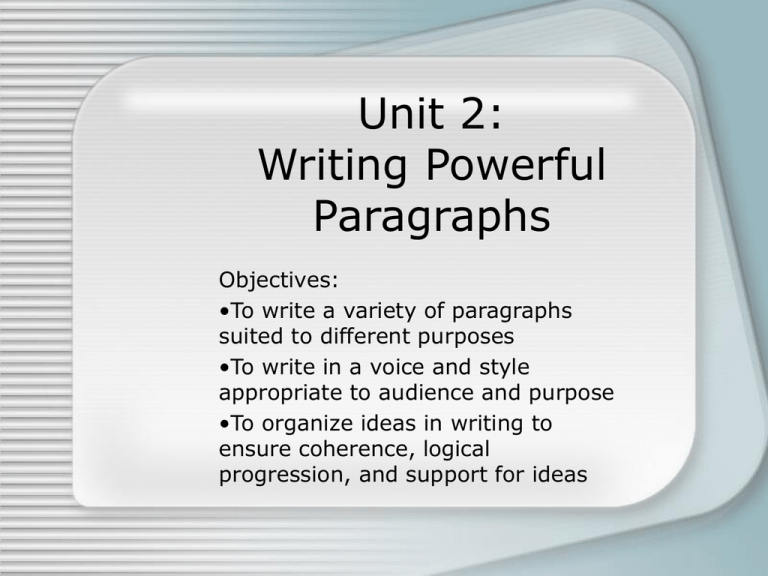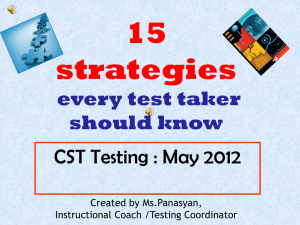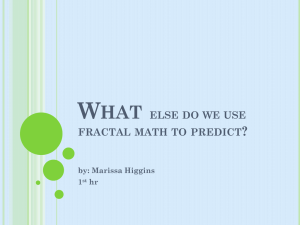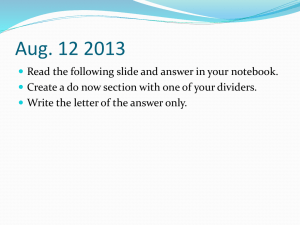Writing to Inform
advertisement

Unit 2: Writing Powerful Paragraphs Objectives: •To write a variety of paragraphs suited to different purposes •To write in a voice and style appropriate to audience and purpose •To organize ideas in writing to ensure coherence, logical progression, and support for ideas II. Writing Informative Paragraphs A. Prewriting • Discovering subjects to write about Experience: interests, skills, hobbies Outside Sources: books, magazines, television, conversations Asking Questions: about what you read or hear 1. Choosing a Subject Choose a subject that interests you Choose a subject that will interest your audience Choose a subject you know enough about or can learn enough about to explain accurately Choose a subject that is limited enough to be adequately explained in one paragraph 2. Explore a subject Freewrite or brainstorm What do I already know that would help me explain my subject clearly to my audience? What further information do I need to find out? Where can I find this information? If you can only think of one or two answers to these questions and cannot think of sources to find more information, you should choose another topic. If your paper becomes scattered with too many ideas, then your topic is probably too broad and needs to be narrowed. 3. Limiting a Subject •Steps in Limiting a Subject Broad Subject Cars Ask Yourself: Which car? More Limited Subject Ask Yourself: 1969 Corvette What interests me about 69’ Corvettes Suitably Limited Subject 1969 Corvettes are very valuable today. 3. Determining Your Audience Audience Profile Questions 1. What do my readers already know about my subject? What else might they need to know as background information? 2. What are my readers’ attitudes toward my subject? If these attitudes differ substantially from mine, how can I address the differences? 3. Why are my readers reading my writing? How can I address their needs 4. Developing Supporting Detail Types of Supporting Detail examples incidents Facts/ statistics reasons directions Steps in a process causes definitions Comparisons / contrasts effects analogies classification s 5. Organizing Details in Logical Order Order of Importance Arrange details in the order of least to most important or most to least important. Developmental Order Arrange your supporting details so that one idea grows out of another. Use when your ideas are of equal importance. Chronological Order Arrange details in the order in which they occur over time. Use to organize the steps in a process or in a set of directions. Spatial Order Place details in the order of near to far, top to bottom, inside to outside, left to right, etc. Use to describe a scene or physical structure. B. Drafting 1. Drafting the Topic Sentence Steps: 1. Look over your prewriting notes 2. Express your main idea in one sentence 3. Revise to clarify your main idea and to control all details Example Prewriting Notes Subject The new high-speed train (MLV) Details •Engineers developed magnetic levitation train (MLV) •Magnets on train motor and rail hold train four to six inches above single rail •Magnetic force also drive train forward •May travel up to 300 miles per hour Example first (piece of garbage) topic sentence: The magnetic levitation vehicle can travel up to 300 miles per hour. Example first (piece of garbage) topic sentence: The magnetic levitation vehicle can travel up to 300 miles per hour. Revised Topic Sentence: A new type of train uses magnetic force to achieve high speeds. 2. Drafting the Body Strategies: • Don’t worry about grammar; you can edit later • Write quick, focusing on getting your ideas down on paper • Combine sentences that seem to go together • To keep your ideas developing logically, pause now and then to reread what you have just written • Where necessary, add words and phrases to help one sentence lead smoothly into the next Transition Words for Four Types of Logical Order Importance Chronological Spatial Developmental even more after above also finally as soon as ahead besides first first behind despite more important at last below for example most important second higher however one reason later inside therefore outside while to begin with meanwhile 3. Drafting the Concluding Sentence Functions: 1. Restates the main idea in fresh words 2. Summarizes the paragraph 3. Evaluates the supporting details 4. Adds insight that emphasizes the main point C. Revising 1. Checking for Adequate Development • Is the reader adequately and clearly informed by the concluding sentence of the paragraph? Inadequately Developed Paragraph The Empire State Building in New York City is one of the most impressive buildings in the world. It once was the world’s tallest building, and it still ranks as one of the tallest. Every year many people visit it. On a clear day, you can see far away. Besides its height the Empire State Building is impressive in other ways, for it has many windows and other things. People visiting New York City should be sure to see the Empire State Building. Adequately Developed Paragraph The Empire State Building in The Empire State Building in New York City is one of the most New York City is one of the impressive buildings in the world. most impressive buildings in Completed in 1931, it was the the world. It once was the world’s tallest building until 1972. world’s tallest building, and it At 1,250 feet it is now the eighth still ranks as one of the tallest building in the world. The two observation decks, which are tallest. Every year many on the 86th and 102nd stories, people visit it. On a clear are visited by 1.5 million people day, you can see far away. every year. From the higher deck Besides its height the Empire on a clear day, observers can see State Building is impressive as far as 80 miles away. Besides in other ways, for it has many its height, the Empire State windows and other things. Building is impressive in other People visiting New York City ways. It has 6,500 windows, 7 should be sure to see the miles of elevator shafts, and 60 miles of water pipes. People who Empire State Building. are visiting New York City should be sure to see the Empire State Building. 2. Checking for Unity • A problem that occurs when one or more supporting sentences stray from the main point. Revising for Unity Predicting Earthquakes Scientists face a difficult yet important task in trying to predict earthquakes. Scientists are usually successful in the end, however. Each year earthquakes take 10,000 to 15,000 lives and cause billions of dollars in damage. Many cities have been totally destroyed. In 1811 and 1812, a series of earthquakes in Missouri changes the course of the Mississippi River, shaking the earth enough to stop the clocks in Boston. Boston is also sometimes struck by tornadoes. Recent efforts to predict earthquakes have met with only limited success. Chinese scientists predicted an earthquake in Haicheng in 1975, and Soviet scientists predicted an earthquake in 1978. To control destruction from earthquakes, scientists must find ways to predict them more consistently. Revising for Unity Predicting Earthquakes Scientists face a difficult yet important task in trying to predict earthquakes. Scientists are usually successful in the end, however. Each year earthquakes take 10,000 to 15,000 lives and cause billions of dollars in damage. Many cities have been totally destroyed. In 1811 and 1812, a series of earthquakes in Missouri changes the course of the Mississippi River, shaking the earth enough to stop the clocks in Boston. Boston is also sometimes struck by tornadoes. Recent efforts to predict earthquakes have met with only limited success. Chinese scientists predicted an earthquake in Haicheng in 1975, and Soviet scientists predicted an earthquake in 1978. To control destruction from earthquakes, scientists must find ways to predict them more consistently.










